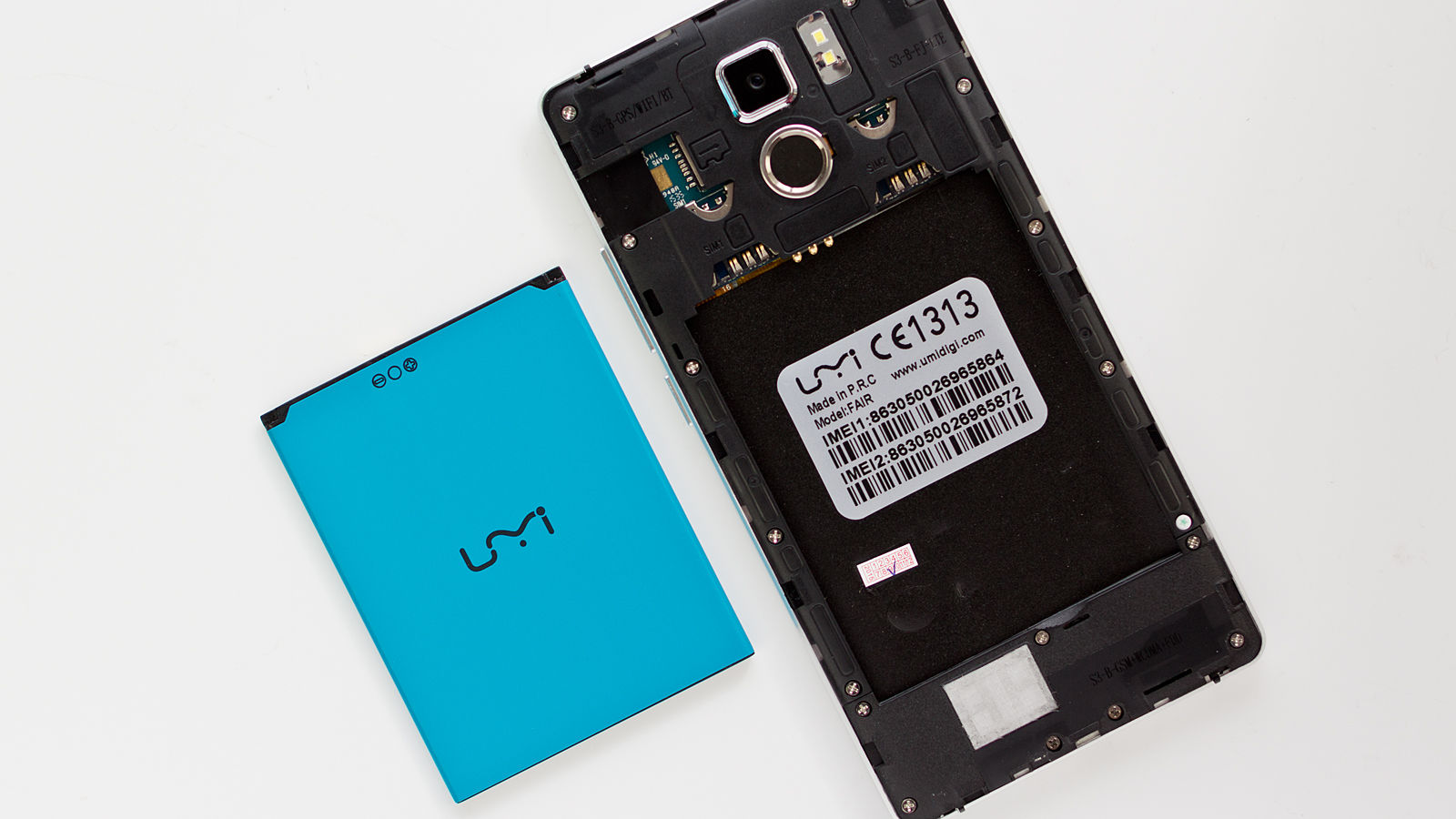UMI Fair review: UK price and availability
Long gone are the days when buying cheap meant you had to skimp on features or performance. The UMI Fair is a budget Android phone available from as little as £61.19 yet it has everything most users will need, including soughtafter features such as microSD support, a removable battery, a fingerprint scanner and dual-SIM 4G LTE capability. The design’s really nice, too. Also see: Best smartphones 2015/2016. That £61.19 price is from Coolicool.com, which sent us the UMI Fair for review. It offers free shipping, but you should take into account the fact you may be required to pay import duty – read our advice on buying grey-market tech. Alternatively, Coolicool.com has stocks in its European warehouse, and the free shipping to the UK is exempt from import duty. You’ll pay a little more, but even at £95.19 the UMI Fair offers excellent value when compared to its closest UK smartphone rivals, such as the Motorola Moto E 4G and Vodafone Smart Prime 6.
UMI Fair review: Build & design
Of the three phones, we think the UMI Fair has the nicest design. While chunkiness is often a telltale sign of a cheap phone it’s both thinner and lighter than the 12.3mm, 145g Moto E and 9mm, 155g Smart Prime 6, just 8.4mm and 120g. Both those phones are built using plastic and, while the UMI’s removable rear cover is plastic, it uses a metal frame that makes it appear much more expensive than it is, and adds durability. Also see: Best Android phones 2015/2016. And, as plastic covers go, UMI has done a great job. This black panel has a soft-touch finish that feels really nice in your hand. There’s a circular fingerprint scanner situated just below the rear 8Mp camera, which falls nicely under the finger as you pick up the phone but you still need to wake the screen before you can unlock it. On the right of the camera is a dual-LED flash. The speaker is also found at the back, firing sound straight into your palm, but excellent audio is not something we would expect from a phone at this price. Unclip the rear cover and you’ll find two Micro-SIM slots and a microSD card slot, plus a removable battery. Everything else is exactly where you’d expect to find it – Micro-USB centred at the bottom, a 3.5mm headphone jack at the top, and a volume rocker and power switch on the phone’s right edge. Also see all Android phone reviews. Despite the reasonable amount of space available below the screen, the back, home and recent touch buttons appear at the bottom of the screen itself. Above the screen is a small speaker grille and 2Mp webcam. The screen is very decent at this price, a 5in HD (1280×720 pixels) IPS panel with a pixel density of 294ppi. This matches the screen of the Smart Prime 6, but is higher in resolution than the 4.5in qHD Moto E 4G. It’s not as sharp, bright or high in contrast as we’d like, and it is prone to greasy fingerprints, but for a phone at this price it’s definitely nothing to grumble at. Viewing angles are excellent and colours are vivid. Also see: Best MiFi 2016.
UMI Fair review: Hardware & performance
Both the UMI Fair’s aforementioned rivals run the Qualcomm Snapdragon 410 quad-core processor with 1GB of RAM, 8GB of storage and support for expansion via microSD. The UMI Fair matches them on RAM and storage, but uses a MediaTek rather than Qualcomm processor. The MTK6736 chip inside the UMI Fair is also a quad-core 64-bit processor, and in our benchmarks appears to be a reasonable match for the Snapdragon 410. (You can compare the UMI Fair’s performance to other Android phones we’ve recently tested in our article What’s the fastest smartphone?) To measure overall performance we run Geekbench 3 and AnTuTu. In Geekbench the UMI Fair recorded 484 points single-core and 1368 multi-core. By comparison the Motorola managed 464 and 1463, and the Vodafone 464 and 1401. In AnTuTu the Vodafone proved the faster device with 21,842 points against the UMI’s 18,989. Graphics are tested using GFXBench, and the UMI Fair proved to be on par with its UK rivals with 4fps in Manhattan and 9fps in T-Rex. The Moto E recorded 6fps and 13fps respectively, while the Vodafone scored 3fps and 9fps. Our final test is SunSpider, for web-browsing performance. The UMI Fair fell down here, recording 2137ms while its two rivals each scored 1301ms (lower is better in this test). See all smartphone reviews. Benchmarks only tell part of the story, however. In real-world use the UMI Fair should be fast enough for most users. It can take a couple of seconds to launch the camera or to unlock the phone using the fingerprint scanner, and moving between menus isn’t as fluid as it might be on a flagship, but for most of the time the UMI Fair has a quite acceptable pace. The 2,000mAh battery is on the small side for an Android phone, but there’s no power-hungry hardware here to chomp through it. The fact the battery is removable is a bonus, too. You should easily get a day’s use out of this phone before needing to recharge it.
UMI Fair review: Connectivity & extras
The fingerprint scanner isn’t the only extra you’ll find in this budget smartphone; there’s also dual-SIM (dual-standby) 4G mobile connectivity. The UMI Fair supports all three UK LTE bands (3, 7 and 20), and accepts two Micro-SIMs. Also see: Best dual-SIM phones 2015/2016 and How to check whether a phone is supported by your network. There’s no NFC, but the UMI Fair supports MediaTek’s equivalent, HotKnot. Other connectivity specs include support for 802.11b/g/n Wi-Fi, Bluetooth 4.0 and GPS.
UMI Fair review: Cameras
The UMI Fair is fitted with an 8Mp, f/2.2 Sony IMX614 camera that uses software to boost to 13Mp. The camera app features all the usual modes, from Face beauty to Panorama, Motion-tracking and Live photo. There’s face detection, smile shot and auto-scene detection, too. Full-HD video-recording is supported. Also see: Best Chinese phones 2015/2016. For a cheap phone we were impressed with the results, especially given the gloomy weather conditions at our time of testing. Some detail is lost, seen on our test shots particularly where the individual bricks are difficult to distinguish, but colours are realistic and the photos are reasonably sharp. A dual-LED flash is also present for helping out in low-light situations. Below you can see a couple of our test shots of the St Pancras Renaissance Hotel, first in auto mode and second with HDR switched on. At the front the UMI is also fitted with a 2Mp, f/2.2 camera with 1.12um pixels for selfies and video chat. Also see: Best phone camera 2015/2016.
UMI Fair review: Software
The UMI Fair is rooted but runs Android 5.1 Lollipop out of the box. The interface is standard Android fare, but there are some tweaks. The Google Play store is preinstalled, but if you want to use other Google apps such as YouTube and Gmail you’ll need to download them yourself. That’s not a bad thing, though, as with only 8GB of storage built-in its nice to find not too much of it is consumed by unneccessary apps you don’t want and can’t install. The key customisations to the OS are found in the addition of smart gestures. These aren’t customisable in the UMI Fair, but there are plenty to choose from, in apps and from standby. For instance, you can double-tap to wake the screen, draw a C to launch the camera, and put the phone to your ear to call a contact. Our only frustration is that you can’t wake the phone using the fingerprint scanner alone. Read next: Best new phones coming in 2016 Follow Marie Brewis on Twitter. Marie is Editor in Chief of Tech Advisor and Macworld. A Journalism graduate from the London College of Printing, she’s worked in tech media for more than 17 years, managing our English language, French and Spanish consumer editorial teams and leading on content strategy through Foundry’s transition from print, to digital, to online - and beyond.







